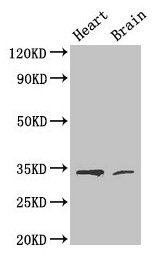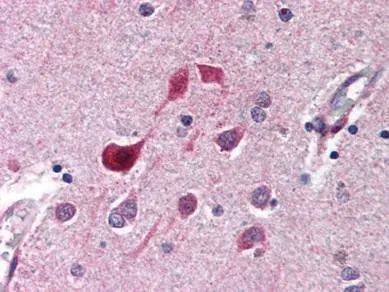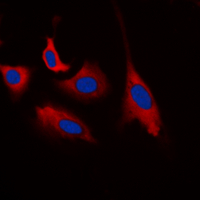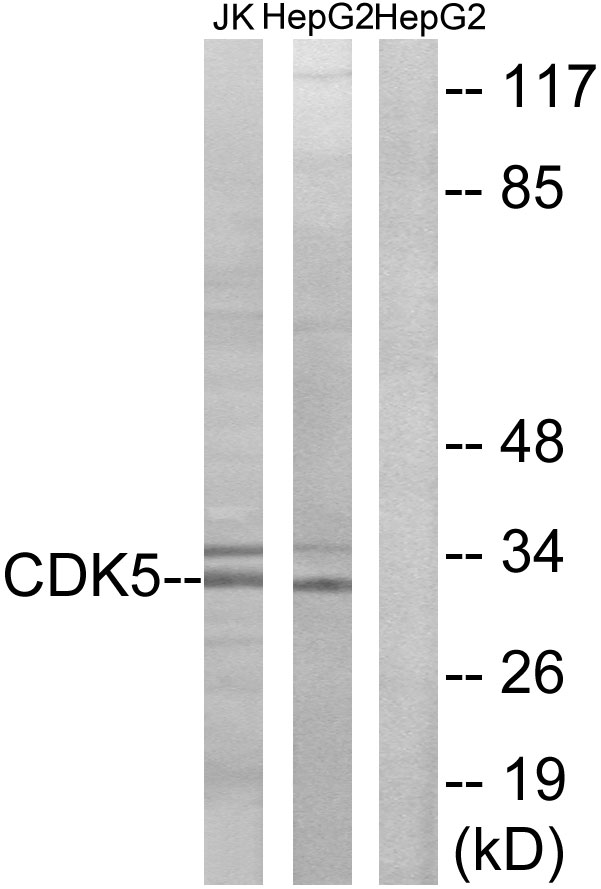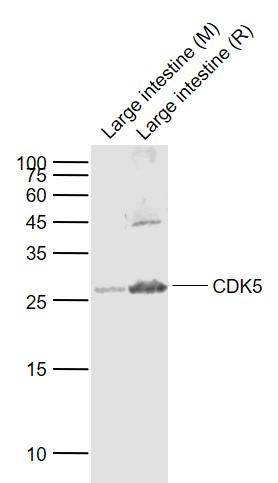![ELISA analysis of antigen using GTX60441 CDK5 antibody [4E4]. Red : Control antigen 100ng Purple : Antigen 10ng Green : Antigen 50ng Blue : Antigen 100ng ELISA analysis of antigen using GTX60441 CDK5 antibody [4E4]. Red : Control antigen 100ng Purple : Antigen 10ng Green : Antigen 50ng Blue : Antigen 100ng](https://www.genetex.com/upload/website/prouct_img/normal/GTX60441/GTX60441_20170912_ELISA_w_23061123_676.webp)
ELISA analysis of antigen using GTX60441 CDK5 antibody [4E4]. Red : Control antigen 100ng Purple : Antigen 10ng Green : Antigen 50ng Blue : Antigen 100ng
CDK5 antibody [4E4]
GTX60441
ApplicationsFlow Cytometry, ImmunoFluorescence, Western Blot, ELISA, ImmunoCytoChemistry, ImmunoHistoChemistry, ImmunoHistoChemistry Paraffin
Product group Antibodies
TargetCDK5
Overview
- SupplierGeneTex
- Product NameCDK5 antibody [4E4]
- Delivery Days Customer9
- Application Supplier NoteWB: 1/500 - 1/2000. ICC/IF: 1/200 - 1/1000. IHC-P: 1/200 - 1/1000. FACS: 1/200 - 1/400. ELISA: 1/10000. *Optimal dilutions/concentrations should be determined by the researcher.Not tested in other applications.
- ApplicationsFlow Cytometry, ImmunoFluorescence, Western Blot, ELISA, ImmunoCytoChemistry, ImmunoHistoChemistry, ImmunoHistoChemistry Paraffin
- CertificationResearch Use Only
- ClonalityMonoclonal
- ConjugateUnconjugated
- Gene ID1020
- Target nameCDK5
- Target descriptioncyclin dependent kinase 5
- Target synonymsLIS7, PSSALRE, cyclin-dependent kinase 5, TPKII catalytic subunit, cell division protein kinase 5, cyclin-dependent-like kinase 5, epididymis secretory sperm binding protein, protein kinase CDK5 splicing, serine/threonine-protein kinase PSSALRE, tau protein kinase II catalytic subunit
- HostMouse
- IsotypeIgG1
- Protein IDQ00535
- Protein NameCyclin-dependent-like kinase 5
- Scientific DescriptionThis gene encodes a proline-directed serine/threonine kinase that is a member of the cyclin-dependent kinase family of proteins. Unlike other members of the family, the protein encoded by this gene does not directly control cell cycle regulation. Instead the protein, which is predominantly expressed at high levels in mammalian postmitotic central nervous system neurons, functions in diverse processes such as synaptic plasticity and neuronal migration through phosphorylation of proteins required for cytoskeletal organization, endocytosis and exocytosis, and apoptosis. In humans, an allelic variant of the gene that results in undetectable levels of the protein has been associated with lethal autosomal recessive lissencephaly-7. Alternative splicing results in multiple transcript variants. [provided by RefSeq, May 2015]
- Storage Instruction-20°C or -80°C,2°C to 8°C
- UNSPSC12352203

![FACS analysis of K562 cells using GTX60441 CDK5 antibody [4E4]. Green : CDK5 Purple : negative control FACS analysis of K562 cells using GTX60441 CDK5 antibody [4E4]. Green : CDK5 Purple : negative control](https://www.genetex.com/upload/website/prouct_img/normal/GTX60441/GTX60441_20170912_FACS_w_23061123_356.webp)
![ICC/IF analysis of GC7901 cells using GTX60441 CDK5 antibody [4E4]. Green : CDK5 Blue: DRAQ5 fluorescent DNA dye Red: Actin filaments ICC/IF analysis of GC7901 cells using GTX60441 CDK5 antibody [4E4]. Green : CDK5 Blue: DRAQ5 fluorescent DNA dye Red: Actin filaments](https://www.genetex.com/upload/website/prouct_img/normal/GTX60441/GTX60441_20170912_ICCIF_w_23061123_364.webp)
![IHC-P analysis of human cerebellum tissue (left) and brain tissue (right) using GTX60441 CDK5 antibody [4E4]. IHC-P analysis of human cerebellum tissue (left) and brain tissue (right) using GTX60441 CDK5 antibody [4E4].](https://www.genetex.com/upload/website/prouct_img/normal/GTX60441/GTX60441_20170912_IHC-P_w_23061123_404.webp)
![WB analysis of HeLa (1), K562 (2), PC-12 (3) and Cos7 (4) cell lysate using GTX60441 CDK5 antibody [4E4]. WB analysis of HeLa (1), K562 (2), PC-12 (3) and Cos7 (4) cell lysate using GTX60441 CDK5 antibody [4E4].](https://www.genetex.com/upload/website/prouct_img/normal/GTX60441/GTX60441_20170912_WB_w_23061123_102.webp)
